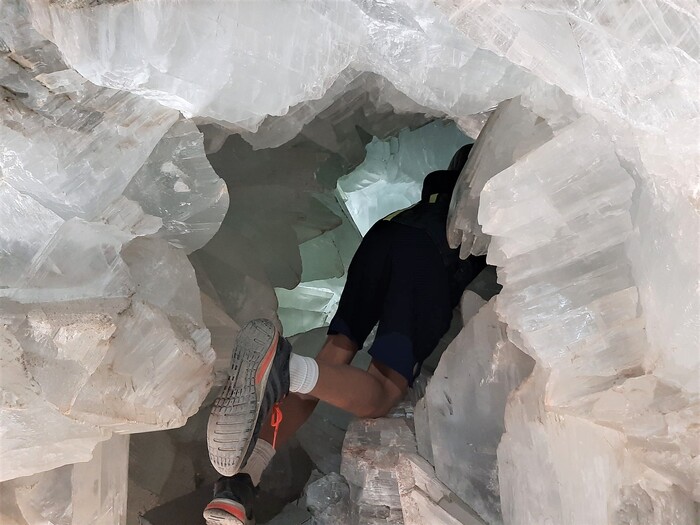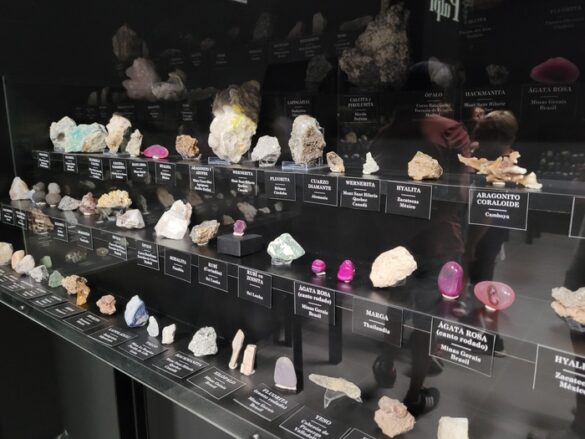PULPI – One by one we put our upper bodies in a dark hole between large crystals. Our guide Milagros increases the tension and waits a while before turning on the light. Invariably we hear a stunned exclamation: “Wow!” We are in the famous Pulpi Geode in the province of Almeria.
We have just seen with our own eyes the largest geode in the world and it was stunning. Like us, scientists are amazed by this unique work of art created through a time-consuming and subtle collaboration of Mother Nature and time. From June 1, 2019, the Pulpi Geode is open to the public. The cave with giant crystals in Almería is now one of the most striking sights in Spain. Since its opening, almost 200,000 people have been able to view this wonder despite all the restrictions during the pandemic period.
What is a Geode?
A geode is a cavity in the rock that is covered with crystals on the inside. Geodes are usually between 2.5 and 30 centimetres in size. However, the ‘Geoda Gigante’ in Pulpi is almost eight metres long, two metres wide and two metres high. The size, the extraordinary transparency of the crystals and their beautiful shapes make this cave unique in the world. Only the crystal cave – not technically a geode – in Naica Mexico is larger. However, this is not accessible to the public due to climatic conditions.
Guided tour by a geologist

We are lucky enough to get to know this unique natural monument under the care of Milagros Carretero Tortosa, geologist and visitor coordinator. In just a few years, the municipality of Pulpi, in collaboration with geologists and other scientists, has transformed it into a very interesting geo-tourism complex. It’s not quite done yet. Until the new visitor centre is ready, visitors will be accommodated in a makeshift reception.
Milagros leads us through the Mina Rica in about an hour and a half to the highlight of our visit. While descending through the mine, the geode is located at a depth of 60 metres, this scientist and expert guide spreads her extensive knowledge about the mine, its history, the geology and the geode itself. She does that so fascinating that we almost forget what we came for.
Mina Rica Pilar de Jaravia
Before you can take a look at the natural wonder, the tour – always with a guide – leads through the Mina Rica Pilar de Jaravia. Pilar de Jaravia is a hamlet belonging to Pulpi in the Sierra del Aguilón. From 1870 until the Spanish Civil War, iron, lead and silver were mined here. That made Almería one of the most important mining districts in Spain at the time.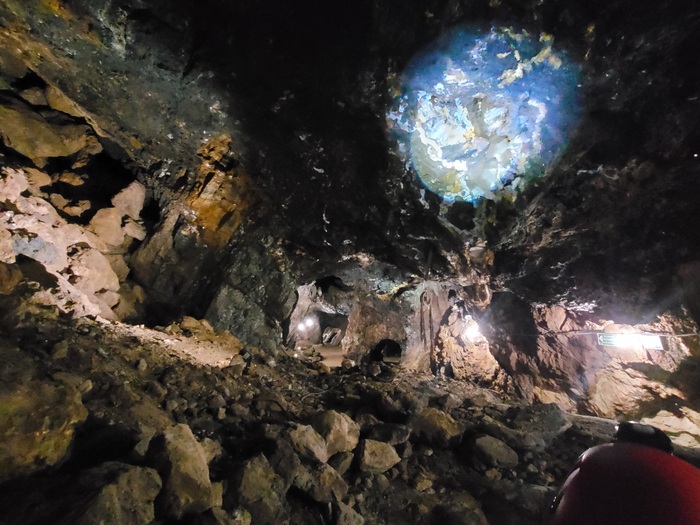
As we walk through dimly lit corridors, Milagros points out special details or places with her flashlight. Numerous minerals sparkle and shine from the rock walls. We also see beautiful colours. This abundance gives the mine its name Mina Rica (rich mine). Even before the discovery of the gigantic geode, large quantities of different types of minerals were found here. Gypsum and Celestine stood out here because of their quality and size.
Most of the minerals listed by Milagros mean little to us until we visit the ‘Sala Negra’ in Pulpi later in the day. There we see the largest display of minerals in the world. With the special lighting, the brown-grey-rust-coloured stones transform into spectacular, brightly coloured appearances. It complements our visit to the mine and the Pulpi Geode nicely.
Geological heritage
Over time, different methods were used in the mine to extract the minerals, as we understand from Milagros. The two main ones were open-air mining and underground exploitation of chambers using dynamite. She points out that the ‘Galería del Polvorón’ (gunpowder) is the best example of the second method of Spanish mining at the beginning of the 20th century.
The successful exploitation of Mina Rica has resulted in the rich geological heritage that visitors now find there. Think of hundreds of metres of corridors, operating rooms, pillars, funnels, wells, stairs, mining cages, machines, tools and ovens. The two types of mines that are accessible have striking names. The first is called ‘Quien tal pensara’ (who would have thought this) and the second is called ‘Por si acaso’ (just in case), referring to possible thoughts of miners who kept uncovering new parts deep in the earth.
Traces of the miners
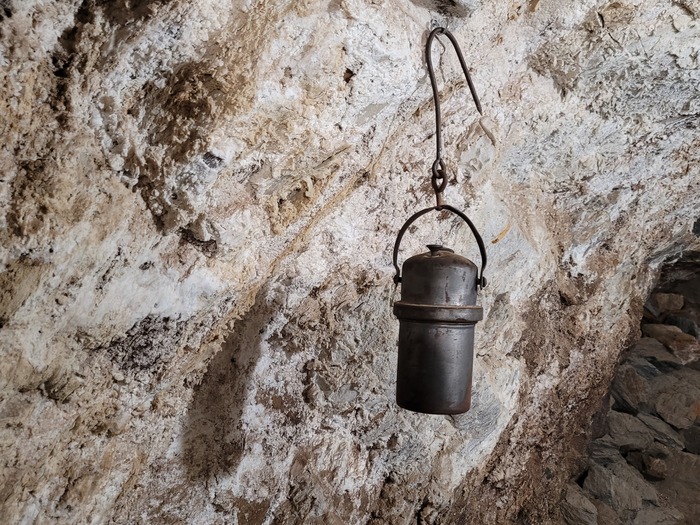
Milagros tells us many anecdotes about what life was like when the mine was still open. She has it first-hand. To do her job as well as possible, she spoke extensively with some still-living miners from the village of old age. This makes everything we see and hear very vivid for us. That effect is further enhanced by the items left behind by the miners and in the fifty-metre long Galería de la Golondrina (the gallery of the swallow) are on display. The corridor owes this name to the swallow-like shape of the crystals here. We see empty beer bottles, tuna cans, a thermos flask, shoes, tools and even texts.
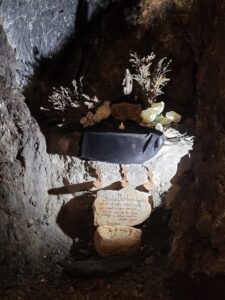
Another witness to the miners’ presence is a small statue of Santa Barbara. Flanked by white plastic roses and dimly lit, this Blessed Virgin protected the miners over the years from her improvised temple. We also see a shoe with a sole of reed. Milagros tells us how that reed had to soak – or boil – in pools on the nearby beach of Los Cocederos (the chutes) before it could be made into the shoes.
The discovery of the Pulpi Geode
In 1999, members of the College of Miners in Madrid, looking for the famous Jaravia gypsum, were surprised to discover at the deepest level of the mine a large cavity in the rock framed by strikingly large crystals. Closer inspection revealed that the cavity was completely covered with giant, transparent gypsum crystals.
Thanks to that discovery, we now descend a long spiral staircase that takes us to the geode. Those with reduced mobility can take the lift. To protect the very fragile crystals, we are provided with a face mask and plastic gloves. Milagros explains that to protect the geode, the thermal conditions in the mine and geode itself are closely monitored and monitored daily by a group of scientists from the University of Alicante.
Pulpi Geode formation
The Pulpi geode is “only” 165,000 years old and formed in the Pleistocene. In fact, gypsum, or calcium sulfate – a very common and common material – forms the basis of this natural wonder. Specific circumstances and a time-consuming process spanning tens of thousands of years have shaped this place into something unique.
Related: Most trendy and unknown places to visit in Spain in 2022
Milagros explains the formation process of this bizarre geode has two phases. First, the formation of the cavity through a Karstic process. The cavity filled with water from the volcano which then evaporated and infiltrated the rock. Secondly, this was followed by the crystallisation process on the inside. We have seen with our own eyes how the crystals resemble large translucent ice floes. But then so transparent that according to Milagros you can read a book through the crystal of at least 20 centimetres thick. We would have loved to try it ourselves, but the geode is so fragile that you can only look at it from the hole.
Practical
The Pulpi Geode is accessible to people from 8 years old. Closed-in shoes must be worn. People in flip flops or heels cannot enter. Reserve tickets in good time via the website of the Geode of Pulpi. Adults pay €22. Children from 8 -16 years €10. If you plan to come in the low season or if you spontaneously consider visiting the geode, you can always try to get a ticket at the entrance. Every half hour a group of up to 12 people enters with a guide. Visitors are not allowed to take photos. Instead, the guides take photos at fixed points that are later provided to the visitors free of charge. An advantage of visiting the geode in the summer is that it is pleasantly cool.
Area
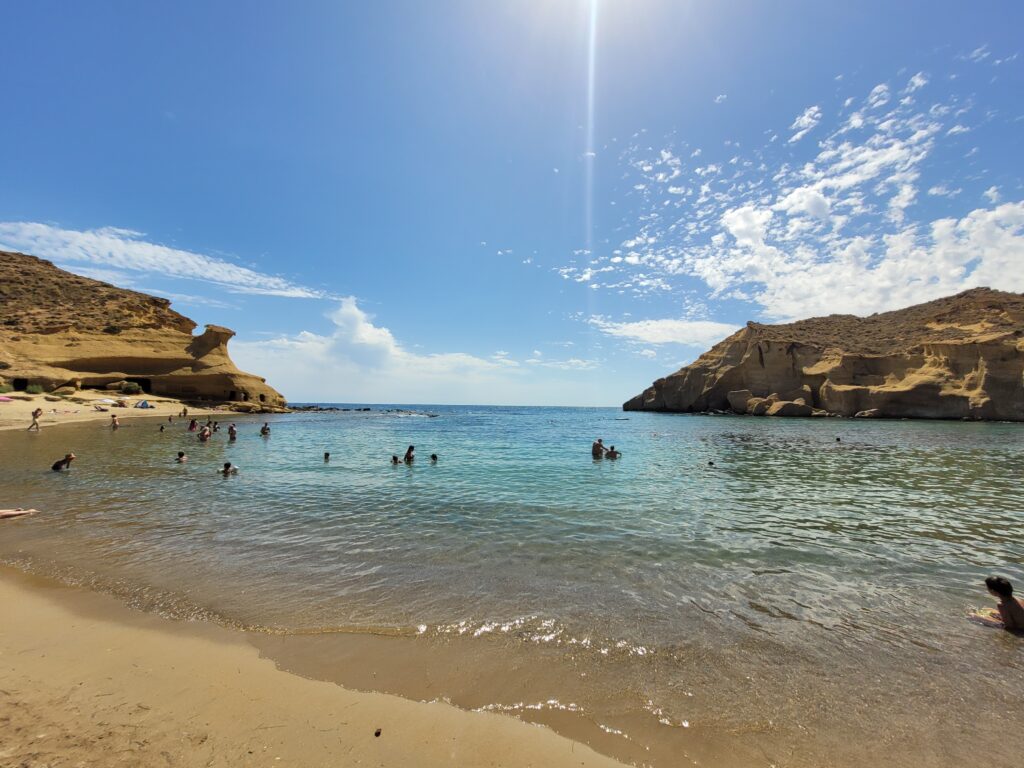
Take a few days to visit the province of Almería. Besides the geode, there is plenty to do here in Pulpí. Included in the entrance to the Pulpi Geode is a visit to the castle of San Juan de Terreros. Here you can even visit the geode virtually with 3D glasses. The view over the area and the sea is spectacular.
On a nice day, visit the beach Playa de los Cocedores. A beautiful round bay with golden rocks from which daredevils can jump and two cosy chiringuitos. Or drive an hour further south where you can visit the beautiful beaches of Cabo de Gata Natural Park. Almeria is also the province where the only desert in Europe is located at Tabernas.
